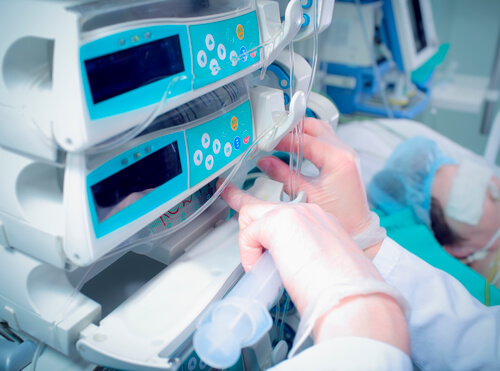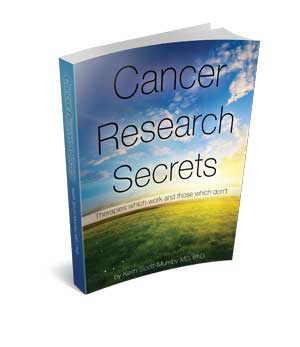I am grateful to my friend and correspondent Grant, from Brooklyn, for calling my attention to this article from the UK’s Daily Telegraph. I don’t read British newspapers, since they stopped featuring me years ago… (It’s just a joke, get it? I’m not that vain… no, really…!)
At last some scientists are waking up to the fact that cancer is a disease, not an alien blob dropped into the body from a flying saucer. I’ve been scoffing at this approach for years, as you know. If it’s a disease, the body will fight it. The body needs help.
Moreover, a cancer IS the body—it’s the person’s own tissues gone bad. We have to heal those tissues and re-harmonize them with the parent body. The dumbest way to get tissues to heal is throw poisons and toxic radiation at them! You start a war and—you know what? Cancer has been winning that war for decades.*
There have been a great many breakthroughs in recent times and ALL amount to the same thing: going with nature, working with the immune system, capturing the power and wisdom of innate healing. It’s the only way to win this “war”.
The trouble is there are people who don’t really want to win the war, as you know, but let’s not go there today.
Instead, we have more support for the natural healing theory. Well, I shouldn’t say entirely natural. But they have shown that high-dose chemotherapy doesn’t work well, is too toxic and does damage in its own right.
Something else you may not know: blasting the tumor with chemo is actually creating resistant cancer cells. It’s like the antibiotic story. Start indiscriminate killing and survivors come out toughest. “My enemy makes me stronger” applies in nature too. What emerges from a course of chemo (or radiation) is all-too-often a type of cell that is tough, resistant and lethal.
Hence, it’s more than a suspicion the chemo will actually kill you.
Now they have tried working with far lower doses and getting good results. Don’t kill cancer, learn to live with it, say scientists. What they mean is give the body time to do its own work. Controlling cancer rather than trying to kill it could be the best way to fight the disease, according to the latest view.

Chemotherapy to Low-Dose Chemotherapy
You have probably heard of insulin potentiated treatment (IPT) for cancer (it’s in my big fat compendium of alternative and safe cancer therapies called Cancer Research Secrets).
The idea is to weaken the cancer cells by dropping the patient’s blood sugar with insulin (cancer feeds on sugar, as we know) and then—when the tumor cells are weak and dizzy from hunger—lay into them with a much gentler form of chemo. Low-dose chemotherapy that doesn’t do a fraction as much damage as the crazy “blast everything in sight, good or bad” approach.
Of course this will be fought: “low-dose” chemotherapy means lower profits, so don’t expect it to be embraced overnight!
But the headlines are out there at last: Managing cancer with low-dose chemotherapy could be more effective than attempting to kill the disease, scientists believe. Daily Telegraph, 24 Feb 2016.
The controversial approach that was on trial suggests that cancer patients may have a better chance of survival if they live with their illness long term. Well, obviously!
If you don’t kill him or her with the “treatment”, of course you are going to improve the outcomes for that patient. But this blast-and-kill strategy is very ingrained in the medical culture. For a long time to come it will be billed as “the proper treatment”—not that it does any good but that it’s what everybody else is doing, ploughing their financial furrow. Most doctors don’t dare step out of line.
“The potential to reduce grueling side-effects of chemotherapy, while increasing the treatment’s effectiveness, could dramatically improve the lives of people with breast cancer” —Rachel Rawson, Breast Cancer Care
Current cancer treatments usually involve aggressive treatment with absurdly high doses chemotherapy in an attempt to wipe out as many tumor cells as possible. But complete eradication of cancer is not a realistic possibility. There will always be some hidden cells which survive, to go on and become a new threat and a tumor is much more likely to be fatal the second time.
And the side effects are notoriously grim: hair loss, nausea and extreme fatigue, but also crippling the body’s immune system or triggering anemia.
The new low-dose chemotherapy strategy is designed to prevent drug-resistant tumor cells getting established. Rather than trying to eradicate a tumor, the treatment stabilizes it by deliberately allowing a small population of drug-sensitive tumor cells to survive.
Those are a sort of “good guys”. You know… the crooks that you could trust with a gun, to help you wipe out a gang of drug-dealers or terrorists.
The drug paclitaxel was tested by a team of US scientists led by Dr. Robert Gatenby, from the H Lee Moffitt Cancer Centre and Research Institute in Tampa, Florida, using it for chemotherapy to treat mice with two different kinds of breast cancer.
Standard chemotherapy initially shrank the mouse tumors, but as soon as the treatment stopped they grew back. Nothing new there. We see it all the time (but they still want you to pay $500,000 for it).
However giving an initial brief high dose followed by continuing regular lower doses successfully controlled cancer growth. In fact, the treatment was so effective that the majority of the mice were weaned off the drug completely over an extended period of time, without suffering relapses!
This will be great when it gets to human treatments.
Writing in the peer-reviewed journal Science Translational Medicine, Dr. Gatenby said:
“Our results suggest that this adaptive therapeutic (AT) strategy can be adapted to clinical imaging and can result in prolonged progression-free survival in breast cancer.”
“Finally, we note that the evolutionary principles that govern AT may be applicable to a wide range of breast cancer treatments including hormonal manipulation and immunotherapy, although they will need to undergo further testing in those settings.”
Rachel Rawson, senior clinical nurse specialist from the charity Breast Cancer Care, said the proposed treatment was ‘an exciting avenue to explore.’
“The potential to reduce grueling side-effects of chemotherapy, while increasing the treatment’s effectiveness, could dramatically improve the lives of people with breast cancer. This is an exciting avenue to explore,” she told The Daily Telegraph.
“However there remains a long road from this study on mice to any potential changes in clinical practice. And we want to reassure anyone concerned, the treatment currently out there has been successfully trialed on thousands of patients.”
I’ll just slightly modify that final misleading quote: the treatment currently out there has been UN-successfully trialed on thousands of patients.
Still, this is a step forward, don’t you think?
Source:
*Cancer Research UK previously calculated that more than one person in three would develop cancer at some point during their life – in other words, the so-called ‘lifetime risk’ was more than 1 in 3.
But their latest estimate, which uses the most accurate calculation method to date, now puts everyone’s chances of developing the disease at 1 in 2. That’s the figure I’ve been upholding for years. It means you or a loved one will be battling cancer at some stage.
Hence the powerful need for an important objective estimation and description of the value of various alternative and holistic cancer therapies, as described in my “encyclopedia” of therapies: Cancer Research Secrets!
Read some great 10+ years survival stories here.

